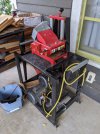You are using an out of date browser. It may not display this or other websites correctly.
You should upgrade or use an alternative browser.
You should upgrade or use an alternative browser.
I bought a thrift store Williams & Hussey
- Thread starter Sourwould
- Start date
Is it a molding cutter?
Oh, yes. Probably should have said that. I guess it's also a 6" planer. Has straight knives in it.
how much did you pay for it? there was no knives?
how much did you pay for it? there was no knives?
I paid $95
What kind of cutters does a machine like that use? Are they the same as for a shaper?
They look like planer knives. Just high speed steel. I was looking on the W&H website, and they do have a shaper head available. Though I'm not sure why that's an advantage.
This is not a great picture (it was dark), but here's a shot of one of the cutter walls at Garland in Durham. These are not for a W&H, but it's a similar knife.
They're used in this giant machine, which is as big as my car.
Actually, any of those knives you see with the holes in them you can run in that machine as long as theyre not over 7" I believe. There are several different cutterheads for large moulders like that antique pictured. There are "widow makers" and serrated edge steel cutters. The widow makers apparently used to lose the cutters during use and impale shop personnel. I have a few of these for my shaper. All the newer machines use serrated steel. The serrations hold the into the cutterhead and are also used for indexing the cutters radially. the real advantage a W&H type moulder has is it will do curved mouldings, all you have to do is make your blank whatever shape and run it through a special jig they have with wheels to hold the blank as its being fed through. Thats a dying art now since they now sell flexible mouldings in many profiles. Although I think a W&H is still required for eliptical mouldings.
I'm pretty sure those cutters have a different bolt pattern for larger bolts, those cutters are really big and thick.
The cutters I've seen called widow makers were a friction fit.
I think the real bread and butter for this kind of machine is the ability to reproduce unavailable trim profiles for historical restoration/remodel. All in a small package that doesn't require a crane to move and is in budget for a small operation.
Even when "matching" historical trim to what's currently available, the newer profe is flatter (if that makes sense). I guess it's to save wood.
Plus you can have your trim in whatever flavor you want. We recently reproduced some column base in KDAT for a porch trim out and some crown in acoya (not sure in that spelling) for a widow's walk.
The cutters I've seen called widow makers were a friction fit.
I think the real bread and butter for this kind of machine is the ability to reproduce unavailable trim profiles for historical restoration/remodel. All in a small package that doesn't require a crane to move and is in budget for a small operation.
Even when "matching" historical trim to what's currently available, the newer profe is flatter (if that makes sense). I guess it's to save wood.
Plus you can have your trim in whatever flavor you want. We recently reproduced some column base in KDAT for a porch trim out and some crown in acoya (not sure in that spelling) for a widow's walk.
Tom Silva of This Old House has one of these machines. For a short run of molding, you can use just one knife, and a counter balance blank in the other slot. For $95 did you use a gun, or a bazooka?
I batted my eyelashes!
I have been running one for quite a while. Impressive machines and you can produce moldings quickly. You can build eliptical jigs for curved moldings as well. Limitation is they can not do more than 3/4" depth of cut. One of the largest moldings I've run is the chicago bar rail
LATEST FOR SALE LISTINGS
-
-
Graco 395 FinishPro air assisted airless sprayer for sale
- Started by RobH
- Replies: 1
-
-
-

